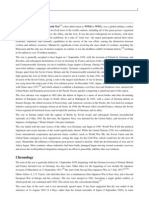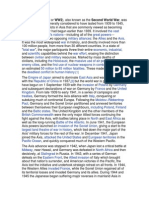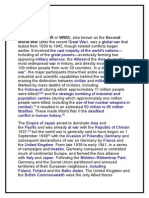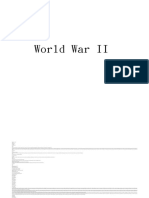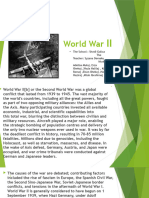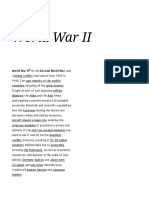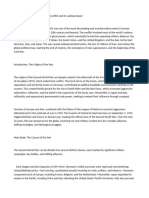Sobolingozaur
Sobolingozaur
Uploaded by
Emil IlieCopyright:
Available Formats
Sobolingozaur
Sobolingozaur
Uploaded by
Emil IlieOriginal Description:
Copyright
Available Formats
Share this document
Did you find this document useful?
Is this content inappropriate?
Copyright:
Available Formats
Sobolingozaur
Sobolingozaur
Uploaded by
Emil IlieCopyright:
Available Formats
egained its territorial losses and turned toward Germany and its allies.
During
1944 and 1945 the Japanese suffered major reversals in mainland Asia, in Central
China, South China and Burma, while the Allies crippled the Japanese Navy and
captured key Western Pacific islands.
The war in Europe concluded with an invasion of Germany by the Western Allies and
the Soviet Union, culminating in the capture of Berlin by Soviet troops, the
suicide of Adolf Hitler and the German unconditional surrender on 8 May 1945.
Following the Potsdam Declaration by the Allies on 26 July 1945 and the refusal of
Japan to surrender under its terms, the United States dropped atomic bombs on the
Japanese cities of Hiroshima and Nagasaki on 6 and 9 August, respectively. With an
invasion of the Japanese archipelago imminent, the possibility of additional atomic
bombings, the Soviet entry into the war against Japan and its invasion of
Manchuria, Japan announced its intention to surrender on 15 August 1945, cementing
total victory in Asia for the Allies. Tribunals were set up by the Allies, and war
crimes trials were conducted in the wake of the war both against the Germans and
against the Japanese.
World War II changed the political alignment and social structure of the globe. The
United Nations (UN) was established to foster international co-operation and
prevent future conflicts; the victorious great powers—China, France, the Soviet
Union, the United Kingdom, and the United States—became the permanent members of
its Security Council. The Soviet Union and the United States emerged as rival
superpowers, setting the stage for the nearly half-century-long Cold War. In the
wake of European devastation, the influence of its great powers waned, triggering
the decolonisation of Africa and Asia. Most countries whose industries had been
damaged moved towards economic recovery and expansion. Political integration,
especially in Europe, began as an effort to forestall future hostilities, end pre-
war enmities and forge a sense of common identity.
You might also like
- World War IIDocument35 pagesWorld War IIMitko67% (3)
- WW 2Document2 pagesWW 2giberozashviliNo ratings yet
- World War II (Often Abbreviated To WWII or WW2), Also Known As The Second World War, WasDocument2 pagesWorld War II (Often Abbreviated To WWII or WW2), Also Known As The Second World War, WasPopulară SălajNo ratings yet
- World War II War (1 September 1939 - 2 SeptemberDocument7 pagesWorld War II War (1 September 1939 - 2 SeptemberjoshithavallabineniNo ratings yet
- World War IIDocument2 pagesWorld War IIhuseikha velayazulfahdNo ratings yet
- Al Doilea Razboi Mondial 2Document1 pageAl Doilea Razboi Mondial 2CaddyNo ratings yet
- World War 2Document4 pagesWorld War 2zaindopasiNo ratings yet
- World War II Wwii WW2 Second World WarDocument2 pagesWorld War II Wwii WW2 Second World Warnani3030No ratings yet
- World War II (WWII or WW2), Also Known As The Second World War, Was ADocument2 pagesWorld War II (WWII or WW2), Also Known As The Second World War, Was AElcangri20No ratings yet
- World War IIDocument1 pageWorld War IIGiggiNo ratings yet
- World War II: World War II (WWII or WW2), Also Known As The Second World War, Was ADocument2 pagesWorld War II: World War II (WWII or WW2), Also Known As The Second World War, Was AscribdslaskNo ratings yet
- World War II (Often Abbreviated To WWII or WW2), Also Known As The Second World War, WasDocument1 pageWorld War II (Often Abbreviated To WWII or WW2), Also Known As The Second World War, WasWinter PartyNo ratings yet
- World War II (WWII or WW2), Also Known As The Second World War, Was ADocument2 pagesWorld War II (WWII or WW2), Also Known As The Second World War, Was AMoimen Dalinding UttoNo ratings yet
- World War IIDocument3 pagesWorld War IIDarshan M MNo ratings yet
- World War 2Document3 pagesWorld War 2millsNo ratings yet
- WW 2Document2 pagesWW 2DianaNo ratings yet
- World War II-WPS OfficeDocument2 pagesWorld War II-WPS OfficemikaNo ratings yet
- World War II: World War II (WWII or WW2), Also Known As The Second World War, Was A Global WarDocument5 pagesWorld War II: World War II (WWII or WW2), Also Known As The Second World War, Was A Global WarEmanu33lNo ratings yet
- World War II (Often Abbreviated To WWII or WW2), Also Known As The Second World War, WasDocument2 pagesWorld War II (Often Abbreviated To WWII or WW2), Also Known As The Second World War, WasrazaibNo ratings yet
- WW2 Research TestDocument2 pagesWW2 Research TestRAFAEL HOMEM-DE-MELONo ratings yet
- World War II (Often Abbreviated To WWII or WW2), Also Known As The Second World War, WasDocument2 pagesWorld War II (Often Abbreviated To WWII or WW2), Also Known As The Second World War, WasŠime PerinovićNo ratings yet
- WW 2Document1 pageWW 2smileskillsme009No ratings yet
- History InformationsDocument6 pagesHistory InformationsramioNo ratings yet
- World War 2Document9 pagesWorld War 2joshiNo ratings yet
- WW 2Document1 pageWW 2ahmednmustafa45No ratings yet
- EnglishDocument13 pagesEnglishadelisamulaj16No ratings yet
- World War II - WikipediaDocument266 pagesWorld War II - WikipediaKennedy BwalyaNo ratings yet
- World War 2 NotesDocument10 pagesWorld War 2 Notesmaxweber0034No ratings yet
- Untitled document (2)Document2 pagesUntitled document (2)figsinxNo ratings yet
- WW 2Document7 pagesWW 2Mity AniNo ratings yet
- World War IIDocument12 pagesWorld War IIIvan LachicaNo ratings yet
- World War II: "WWII" Redirects Here. For Other Uses, SeeDocument7 pagesWorld War II: "WWII" Redirects Here. For Other Uses, SeeSurendra BaleNo ratings yet
- World War 2 Notes For Class PRDocument3 pagesWorld War 2 Notes For Class PRnixeyo2616No ratings yet
- WWIIDocument16 pagesWWIIecaterinaNo ratings yet
- World War IIDocument4 pagesWorld War IISideka ResalsinghNo ratings yet
- World War IIDocument2 pagesWorld War IIlinaungkhantbrainworksNo ratings yet
- Ww 267878Document2 pagesWw 267878daftwellNo ratings yet
- World War IIDocument7 pagesWorld War IIdishijain08No ratings yet
- WW2 HistoryDocument3 pagesWW2 Historyilean.tranxNo ratings yet
- Essay About World War 2Document2 pagesEssay About World War 2matchvollyballNo ratings yet
- PZMJ Ge YP9 WPLNH 6 CHSV IDocument4 pagesPZMJ Ge YP9 WPLNH 6 CHSV Isupriyabharti2207No ratings yet
- World war 2 - notes to studyDocument3 pagesWorld war 2 - notes to studyjunkholdercoNo ratings yet
- The Causes, Effects and Consequences of World War IIDocument1 pageThe Causes, Effects and Consequences of World War IIDanyal KhanNo ratings yet
- WW 2Document1 pageWW 2ahmednmustafa45No ratings yet
- World War IIDocument52 pagesWorld War IIFabián CarlevaroNo ratings yet
- Orld War II, or The Second World WarDocument8 pagesOrld War II, or The Second World WarHamid HasanNo ratings yet
- World War II EventsDocument214 pagesWorld War II EventsSiddharth Shankaran100% (2)
- Documento Sin TítuloDocument4 pagesDocumento Sin TítuloCesar RodriguezNo ratings yet
- Facts About ww2Document2 pagesFacts About ww2nauman shamsherNo ratings yet
- Presentación La Segunda Guerra Mundial y Sus ConsecuenciasDocument29 pagesPresentación La Segunda Guerra Mundial y Sus Consecuenciasfernando100% (1)
- World War IIDocument6 pagesWorld War IIDushan EkanayakeNo ratings yet
- World War 2 InfoDocument2 pagesWorld War 2 InfoLUcas KukasNo ratings yet
- World War II English EssayDocument2 pagesWorld War II English EssaytokyosnightmareNo ratings yet
- World War II Its Background and ConsequencesDocument2 pagesWorld War II Its Background and ConsequencesSMA MAKARIOSNo ratings yet
- World War 2Document3 pagesWorld War 2ROBIN ROLDANNo ratings yet
- World War IIDocument52 pagesWorld War IIPoulami Saanjhbati DasguptaNo ratings yet
- World War II AlliancesDocument4 pagesWorld War II AlliancesMaridel SulbianoNo ratings yet
- 1st Week First Cold War 1945-1961Document17 pages1st Week First Cold War 1945-1961Éssâ HàîdárïNo ratings yet
- World War II (Often Abbreviated To WWII or WW2), Also Known As The Second World War, Was ADocument5 pagesWorld War II (Often Abbreviated To WWII or WW2), Also Known As The Second World War, Was AShlok TrivediNo ratings yet
